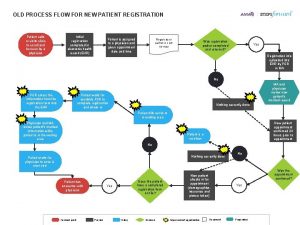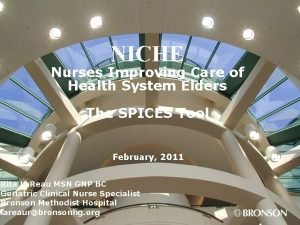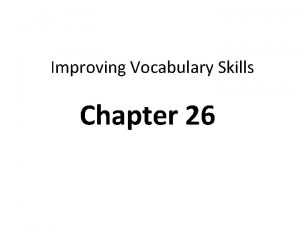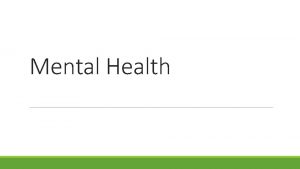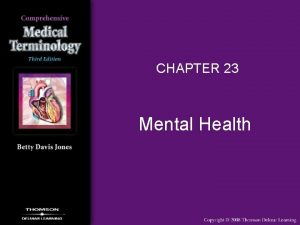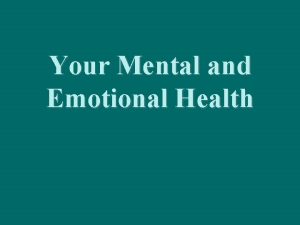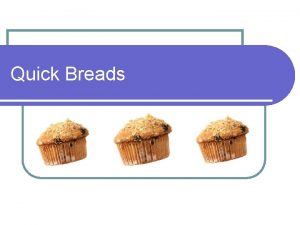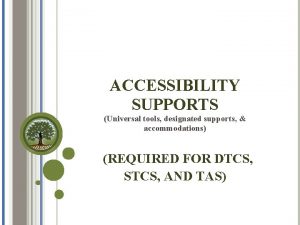Mental Health Improving Mental Health Supports Some quick



















- Slides: 19

Mental Health

Improving Mental Health Supports �Some quick facts: At least one in five children experience significant difficulty requiring support and intervention (For a Board the size of GECDSB that represents 7, 200 students) Children do not grow out of these difficulties For every dollar not spent on early intervention, seven dollars will be spent later on addressing the problem 70% of childhood problems can be solved through prevention, early diagnosis and intervention

Age of Onset of Major Mental Disorders AUTISM ADHD ANXIETY DISORDER OBSESSIVE COMPULSIVE DISORDER SUBSTANCE ABUSE ANOREXIA NERVOSA MAJOR DEPRESSIVE DISORDER BIPOLAR DISORDER SCHIZOPHRENIA BULIMIA NERVOSA 0 10 20 AGE 30

Prevalence of Mental Disorders in Young People Population Translation to the “average” classroom Depression – 6% 2 Students Psychosis – 1% Rare Anxiety Disorders – 10% 3 Students ADHD – 4% Anorexia Nervosa – 0. 2% Total – 15 -20% 1 Student Rare 4 -5 Students

What’s “normal” – otherwise known as distress Common A response to environmental challenges May be adaptive Usually short term and not severe – does not significantly impair functioning Should not be “diagnosed” Usually does not require professional intervention Usually responds well to “usual” supports and positive lifestyle activities

What’s a “mental disorder” Less common Frequent onsets without environmental challenges Frequently long term (may be chronic and episodic) – significant functional impairment Severe (problematic to the individual and others) Must meet recognized diagnostic criteria Frequently requires professional intervention Usually responds well to evidence based treatments Usually helped by appropriate supports and positive lifestyle activities Disturbances of emotion, thinking, and/or behaviour Is rarely, if ever, caused by stress alone

What Mental Disorders Are NOT �It is not the consequence of poor or bad behaviour �It is not the result of personal weakness or deficits in personality. �Only in exceptional cases it is caused by nutritional factors �It is not caused by poverty

How the Brain is Involved �The brain is made up of cells, connection amongst the cells and various neurochemicals �Different parts of the brain are primarily responsible for doing different things (ex. Movement) �Most things a brain does depends on many different parts of the brain working together in a network �The neurochemicals provide a means for different parts of the brain to communicate

What Happens Inside the Brain When it Gets Sick �A specific part of the brain that needs to be working on a specific task is not working well �A specific part of the brain that needs to be working on a specific task is working in the wrong way �The neurochemical messengers that help different parts of the brain communicate are not working properly

How Does the Brain Show it’s NOT Working Well? � If the brain is not working properly, one or more of its functions will be disturbed � Disturbed functions that a person directly experiences (such as sadness, sleep problems, etc. ) are called SYMPTOMS � Disturbed functions that another person sees (such as over activity, withdrawal, etc. ) are called SIGNS � Signs and symptoms BOTH can be used to determine if the brain may not be working well � The person’s usual life or degree of functioning is also disrupted because of the signs and symptoms

Causes �Biological Causes Biochemical Disturbances Genetics Infections- can cause brain damage Brain defects or injury Prenatal damage Poor nutrition, exposure to toxins

Causes �Psychological Causes Severe psychological trauma suffered as a child, such as emotional, physical or sexual abuse An important early loss, such as the loss of a parent Neglect Poor ability to relate to others

Causes � Environmental Factors Death or divorce A dysfunctional family life Living in poverty Feelings of inadequacy, low self-esteem, anxiety, anger or loneliness Changing jobs or schools Social or cultural expectations (For example, a society that associates beauty with thinness can be a factor in the development of eating disorders. ) Substance abuse by the person or the person's parents

Classification of Mental Disorders THINKING/COGNITION BEHAVIOUR PHYSICAL SIGNALING (being responsive & PERCEPTION/SENSING reacting to the EMOTION/FEELING environment) NOTE: When the brain is not functioning properly in one or more of its six domains, and a person experiences problems that interfere with his or her life in a significant way, they may have a mental disorder. BUT… Not all disturbances of brain functioning are mental disorders. Some can be a normal or expected response to the environment – for example: grief when somebody dies

Stigmization � 35% of people with diagnosable disorders seek treatment �The single most common barrier to seeking treatment is SHAME

Types of Mental Illness � Anxiety Disorders � Mood Disorders � Psychotic Disorders � Personality Disorders � Impulse Control and Addictive Disorders � Eating Disorders/Body Image � Other ( Adjustment Disorders, Dissocative Disorders, Factitious Disorders, Sexual and Gender Disorders, Somotoform Disorders, Mental Retardation)

Activities to Improve Mental Health �Activity – Plan it ahead of time (what to do? How often? With whom? ) and then go and do it �Exercise – for example, if you enjoy running, then run 3 x per week with a friend �Eating well – Eating a healthy breakfast, making sure you are getting enough protein, carbs, and healthy fats, etc. �Sleeping well – You should be getting between 8 to 9 hours of sleep EVERY night

Activities to Improve Mental Health Continued…. �Problem Solving – How to deal with stress at home (ie. , learning how to talk about things that upset you) and how to deal with stress at school (ie, when others spread rumours about you). Learn how to keep calm and stay away from negative people. �Being Socially Active – Get involved in sports, clubs, group hobbies, go to the mall, exercise groups, dances, movie nights, etc.

Activities That Should Be Avoided �Using illegal drugs �Too much alcohol �Spending your day in a dark room �Listening to really negative music (Music can have a HUGE influence on your mood) �Avoid spending time with negative people.
 Quick find algorithm
Quick find algorithm Collision forces quick check
Collision forces quick check Mental health and mental illness chapter 20
Mental health and mental illness chapter 20 Mental illness mental health jeopardy
Mental illness mental health jeopardy They say sometimes you win some
They say sometimes you win some Sometimes you win some
Sometimes you win some Countable and uncountable nouns cake
Countable and uncountable nouns cake What are some contact forces and some noncontact forces?
What are some contact forces and some noncontact forces? Fire and ice diamante poem
Fire and ice diamante poem Some say the world will end in fire some say in ice
Some say the world will end in fire some say in ice Some trust in chariots and some in horses song
Some trust in chariots and some in horses song Texas health steps
Texas health steps Ten steps to improving college reading skills 6th edition
Ten steps to improving college reading skills 6th edition User registration process flow diagram
User registration process flow diagram Nurses improving care for healthsystem elders
Nurses improving care for healthsystem elders Chapter 2 sentence check 2 answers curt
Chapter 2 sentence check 2 answers curt Condone noun form
Condone noun form How to improve software economics
How to improve software economics Glencoe health chapter 12
Glencoe health chapter 12 Improving software economics set 1
Improving software economics set 1













